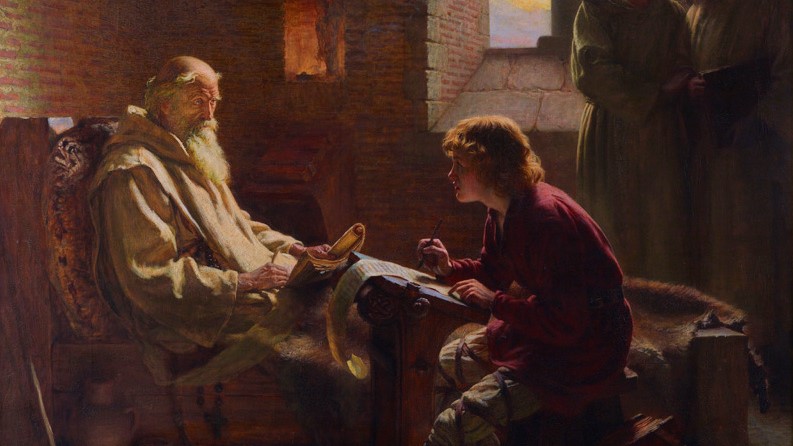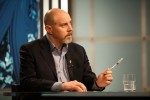

Deacon-structing Doctors of the Church, part 4
Deacon Pedro
Monday, April 26, 2021

Detail of The Last Chapter by J. Doyle Penrose, showing St. Bede the Venerable translating the Gospel of John on his deathbed (Source: Wikimedia Commons)
So far we have learned about St. Gregory the Great, St. Ambrose, St. Augustine, St. Jerome, St. Thomas Aquinas, and St. John Chrysostom in part one; St. Basil the Great, St. Gregory of Nazianzus, St. Athanasius, St. Bonaventure, St. Anselm, and St. Isidore of Seville in part two; and St. Peter Chrysologus, St. Leo the Great, St. Peter Damian, St. Bernard of Clairvaux, St. Hilary of Poitiers, and St. Alphonsus Liguori in part three. I hope that, for the most part, these are saints that you had heard of. They are all Doctors of the Church.
Today we will continue with saints that were named Doctors in the 19th century and the early 20th century.
Francis de Sales is known as the Doctor of Charity. He was Bishop of Geneva in the 17th century. Francis de Sales lived during the Protestant Reformation and had a hand in healing many divisions. He was a lawyer and theologian. He wrote many sermons that still exist. He wrote several books, including The Catholic Controversy, The Spiritual Conferences, Practical Piety, The Secret of Sanctity, and The Mystical Explanation of the Canticle of Canticles. His most famous works are Introduction to the Devout Life and Treatise on the Love of God.
 Every week, Deacon Pedro takes a particular topic apart, not so much to explore or explain the subject to its fullness, but rather to provide insights that will deepen our understanding of the subject. And don’t worry, at the end of the day he always puts the pieces back together. There are no limits to deaconstructing: Write to him and ask any questions about the faith or Church teaching: [email protected]. Follow him on Facebook, Twitter and Instagram.
Every week, Deacon Pedro takes a particular topic apart, not so much to explore or explain the subject to its fullness, but rather to provide insights that will deepen our understanding of the subject. And don’t worry, at the end of the day he always puts the pieces back together. There are no limits to deaconstructing: Write to him and ask any questions about the faith or Church teaching: [email protected]. Follow him on Facebook, Twitter and Instagram.
"I say that devotion must be practised in different ways by the nobleman and by the working man, by the servant and by the prince, by the widow, by the unmarried girl, and by the married woman." – St. Francis de SalesCyril of Alexandria is known as the Doctor of the Incarnation. He was Bishop of Alexandria, Egypt, in the 4th century. He was a central figure in the Council of Ephesus, which confirmed the Nicene Creed and asserted Mary as the Mother of God. There were also many Christological controversies at the time, and Cyril was very much involved in resolving them. He was a prolific writer and wrote many scriptural commentaries, as well Christological writings. Among his works are Becoming Temples of God, Formula of Reunion, Five Tomes Against Nestorius, That Christ Is One, and Scholia on the Incarnation of the Only-Begotten.
“As two pieces of wax fused together make one, so he who receives Holy Communion is so united with Christ that Christ is in him and he is in Christ.” – St. Cyril of AlexandriaCyril of Jerusalem was Archbishop of Jerusalem in the 4th century. He was involved in the dispute over Arianism and was exiled more than once. He left many writings that document the formation and instruction of catechumens and on the liturgy. These include 23 lectures, his Catechesis, given to catechumens before and after baptism.
“The Spirit comes gently and makes himself known by his fragrance. He is not felt as a burden, for God is light, very light.” – St.Cyril of JerusalemJohn Damascene was a priest and monk who lived in Damascus in the 8th century. He was a philosopher who wrote many doctrinal works, particularly against the iconoclasts, who opposed the use of religious images. He also made many contributions in the areas of law, theology, and music. He also wrote against various heretics: the Jacobites, the Nestorians, the Manichees, and the Monothelites. Other than his three Apologetic Treatises Against Those Decrying the Holy Images, he wrote Fountain of Knowledge, Elementary Introduction Into Dogmas, On Right Thinking, On the Two Wills in Christ, Sacred Parallels, and On Dragons and Ghosts, among others.
“Evil is nothing else than absence of goodness, just as darkness also is absence of light. For goodness is the light of the mind, and, similarly, evil is the darkness of the mind.” – St. John DamasceneBede the Venerable is also known as the Doctor of the English. He was a priest and Benedictine monk who lived in England in the 8th century. He was an author, teacher, and scholar. His most famous work is Ecclesiastical History of the English People. He also penned many ecumenical writings and several scriptural commentaries, as well as educational and scientific works, hymns, and poetry. Other historical works include On the Reckoning of Time and Greater Chronicle and a listing of saints, the Martyrology.
“Unfurl the sails, and let God steer us where He will.” – St. Bede the VenerableEphrem the Syrian was a deacon who lived in Edessa, where he founded a theological school in the 4th century. He is known as one of the most notable hymn writers of Eastern Christianity, with over four hundred hymns to his name. He was an ascetic who was zealous in writing and preaching against the errors of his time. He would write “hymns against heresies” that were filled with doctrinal messages. He wrote several biblical commentaries as well as several works against heresy, as well as biographies of saints.
“Scripture brought me to the Gate of Paradise, and the mind stood in wonder as it entered.” – St. Ephrem the SyrianThe more I read about these Doctors of the Church, the more overwhelmed I feel at how little about our faith I know. I hope that these short paragraphs inspire you to read more about some of these great saints of our Church. Come back next week and learn about Peter Canisius, John of the Cross, Robert Bellarmine, Albertus Magnus, Anthony of Padua, and Lawrence of Brindisi.
 Every week, Deacon Pedro takes a particular topic apart, not so much to explore or explain the subject to its fullness, but rather to provide insights that will deepen our understanding of the subject. And don’t worry, at the end of the day he always puts the pieces back together. There are no limits to deaconstructing: Write to him and ask any questions about the faith or Church teaching: [email protected]. Follow him on Facebook, Twitter and Instagram.
Every week, Deacon Pedro takes a particular topic apart, not so much to explore or explain the subject to its fullness, but rather to provide insights that will deepen our understanding of the subject. And don’t worry, at the end of the day he always puts the pieces back together. There are no limits to deaconstructing: Write to him and ask any questions about the faith or Church teaching: [email protected]. Follow him on Facebook, Twitter and Instagram.Related Articles:
<<













